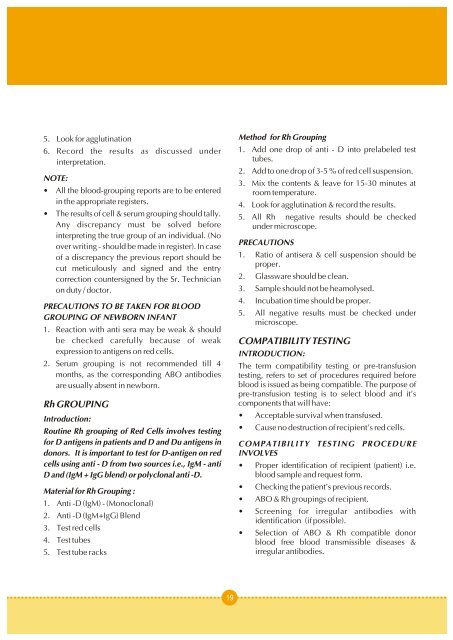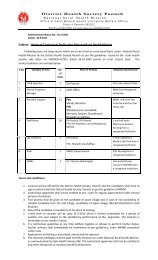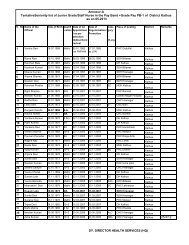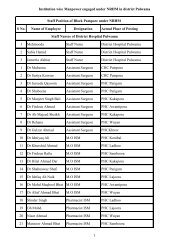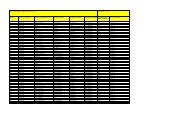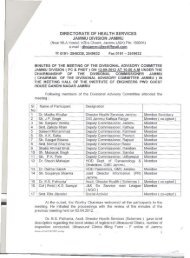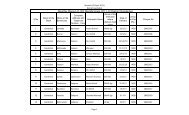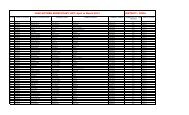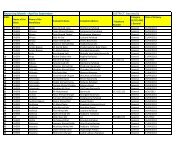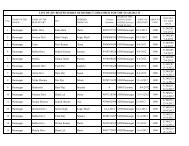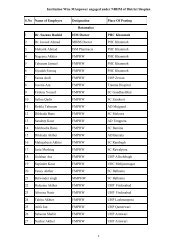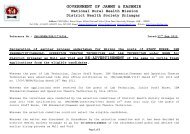Guidelines for Setting Up Blood Storage Centres - NRHM Tripura
Guidelines for Setting Up Blood Storage Centres - NRHM Tripura
Guidelines for Setting Up Blood Storage Centres - NRHM Tripura
You also want an ePaper? Increase the reach of your titles
YUMPU automatically turns print PDFs into web optimized ePapers that Google loves.
5. Look <strong>for</strong> agglutination<br />
Method <strong>for</strong> Rh Grouping<br />
6. Record the results as discussed under 1. Add one drop of anti - D into prelabeled test<br />
interpretation.<br />
tubes.<br />
2. Add to one drop of 3-5 % of red cell suspension.<br />
NOTE:<br />
3. Mix the contents & leave <strong>for</strong> 15-30 minutes at<br />
• All the blood-grouping reports are to be entered room temperature.<br />
in the appropriate registers. 4. Look <strong>for</strong> agglutination & record the results.<br />
• The results of cell & serum grouping should tally. 5. All Rh negative results should be checked<br />
Any discrepancy must be solved be<strong>for</strong>e under microscope.<br />
interpreting the true group of an individual. (No<br />
over writing - should be made in register). In case<br />
PRECAUTIONS<br />
of a discrepancy the previous report should be 1. Ratio of antisera & cell suspension should be<br />
proper.<br />
cut meticulously and signed and the entry<br />
correction countersigned by the Sr. Technician 2. Glassware should be clean.<br />
on duty / doctor.<br />
3. Sample should not be heamolysed.<br />
4. Incubation time should be proper.<br />
PRECAUTIONS TO BE TAKEN FOR BLOOD<br />
5. All negative results must be checked under<br />
GROUPING OF NEWBORN INFANT<br />
microscope.<br />
1. Reaction with anti sera may be weak & should<br />
be checked carefully because of weak COMPATIBILITY TESTING<br />
expression to antigens on red cells.<br />
INTRODUCTION:<br />
2. Serum grouping is not recommended till 4 The term compatibility testing or pre-transfusion<br />
months, as the corresponding ABO antibodies testing, refers to set of procedures required be<strong>for</strong>e<br />
are usually absent in newborn.<br />
blood is issued as being compatible. The purpose of<br />
pre-transfusion testing is to select blood and it’s<br />
Rh GROUPING<br />
components that will have:<br />
Introduction:<br />
• Acceptable survival when transfused.<br />
Routine Rh grouping of Red Cells involves testing<br />
• Cause no destruction of recipient’s red cells.<br />
<strong>for</strong> D antigens in patients and D and Du antigens in COMPATIBILITY TESTING PROCEDURE<br />
donors. It is important to test <strong>for</strong> D-antigen on red INVOLVES<br />
cells using anti - D from two sources i.e., IgM - anti • Proper identification of recipient (patient) i.e.<br />
D and (IgM + IgG blend) or polyclonal anti -D.<br />
blood sample and request <strong>for</strong>m.<br />
• Checking the patient’s previous records.<br />
Material <strong>for</strong> Rh Grouping :<br />
• ABO & Rh groupings of recipient.<br />
1. Anti -D (IgM) - (Monoclonal)<br />
• Screening <strong>for</strong> irregular antibodies with<br />
2. Anti -D (IgM+IgG) Blend<br />
identification (if possible).<br />
3. Test red cells<br />
• Selection of ABO & Rh compatible donor<br />
4. Test tubes blood free blood transmissible diseases &<br />
5. Test tube racks<br />
irregular antibodies.<br />
19


